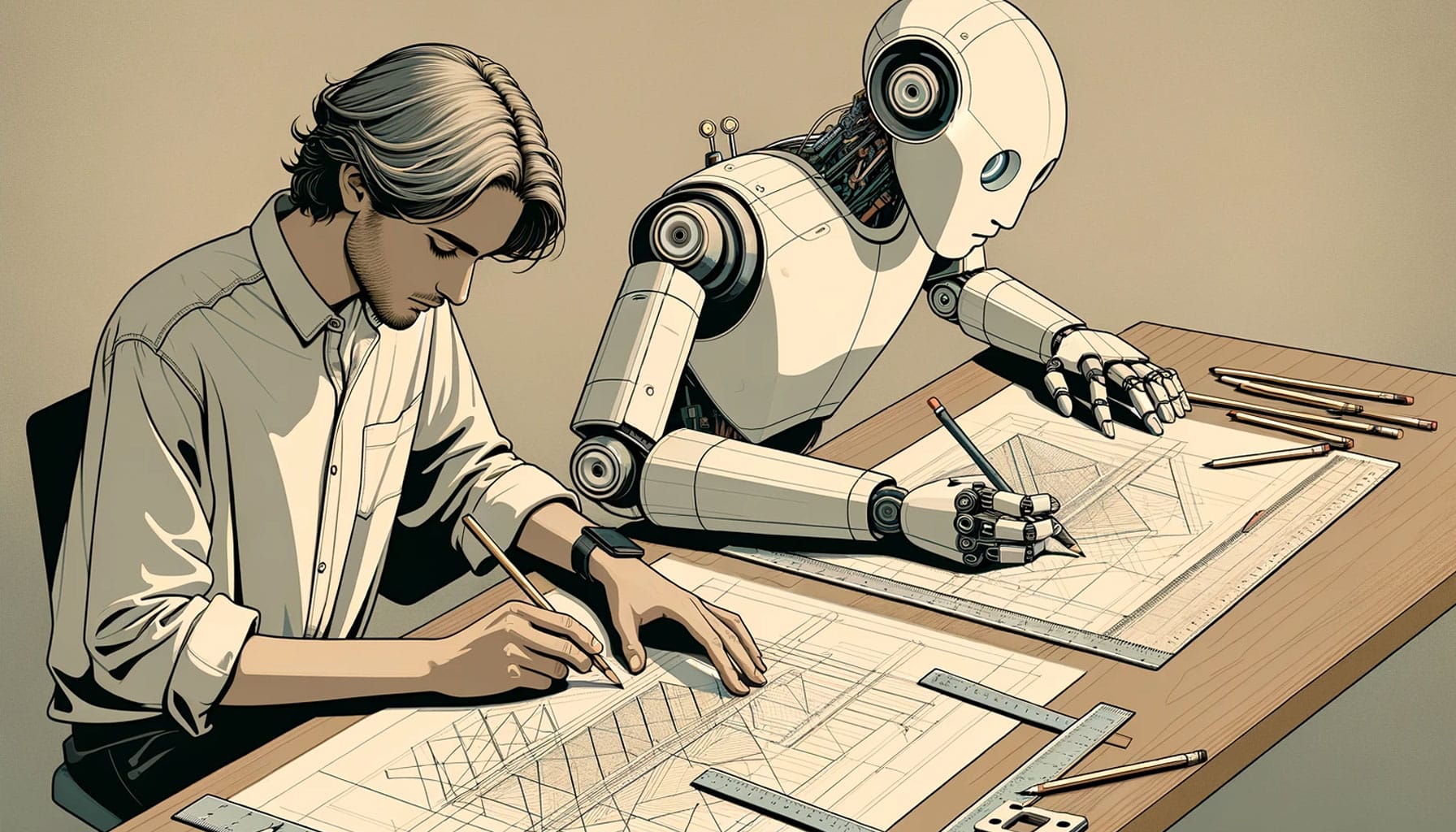You’ve heard the buzz: AI is invading the design world. But can it truly replace human creativity? In this tech-savvy exploration, we’ll dissect AI design tools, weigh their pros and cons, and challenge their potential to outshine human designers. Stick around if you’re curious about the future of design in the hands of artificial intelligence. Let’s dive into the intriguing intersection of AI and creativity. Can machines really match the human touch? Let’s find out.
Understanding AI in Design
To grasp the role of AI in design, you’ve got to understand its capabilities and limitations. AI design tools, equipped with machine learning algorithms, can analyze patterns and trends faster than any human designer. They’ve transformed the way we approach design, especially in the field of graphic design. As we delve into the best AI design tool options, it becomes evident how these tools have become integral in modern design processes.
But understanding AI in design isn’t just about recognizing its strengths. It’s also about acknowledging what it can’t do. Despite its impressive capabilities, AI can’t replace human designers entirely. It lacks the ability to understand the nuances of human emotion and intuition that are often integral to effective design.
AI in graphic design can automate repetitive tasks, generate countless design variations, and even predict design trends. Yet, it can’t interpret client briefs, empathize with user experiences, or make creative decisions based on gut feelings. It’s a tool to enhance, not replace, human creativity.
Pros and Cons of AI Design Tools
While you’re considering the use of AI design tools, it’s crucial to weigh their pros and cons, as they can greatly impact your design process and outcomes.
On the plus side, AI design tools offer speed and efficiency unmatched by human designers. They can generate numerous design options in a fraction of the time, reducing the time and financial investment of your project. Furthermore, they are capable of utilizing vast amounts of data, allowing for more informed and accurate designs.
However, there are also limitations of AI to consider. No matter how advanced, AI design tools cannot replace the human touch in design. They lack the ability to fully comprehend and integrate the nuances of human emotion and cultural context into their designs. This can result in designs that feel impersonal or out of touch.
Moreover, AI tools are only as good as the data they’re fed. They can’t think outside the box or innovate in the same way a human designer can. This can limit their effectiveness in projects needing fresh, unique ideas.
As you weigh these pros and cons of AI design tools, consider how they fit into the bigger picture. This leads us to our next discussion: AI versus human creativity.
AI Versus Human Creativity
In the face of AI’s efficiency, you might question the place of human creativity, especially in light of AI’s limitations. When it comes to AI versus human creativity, it’s essential to remember that AI tools, while advanced, still operate within pre-set parameters. This restricts them from the spontaneous and intuitive creativity that humans can bring to design workflow.
You’ll find that AI tools can replicate patterns, generate countless design variations, and even learn from feedback. However, they lack the ability to push boundaries and create something truly original. They can’t replace human designers because their scope is fundamentally limited by their programming.
Consider this: Can AI replace graphic designers in creating a logo that captures the spirit of a brand, or a website layout that resonates with a target audience? The answer, for now, is no. AI can’t feel a brand’s personality, nor can it empathize with an audience’s desires.
Don’t write off AI tools just yet, though. They’re excellent for automating repetitive tasks, which can free up humans to focus on what they do best: being creative. Now, let’s delve into the future implications for designers.
Future Implications for Designers
So, as a designer, you’re probably wondering what this means for your future. In the rapidly evolving future of design, AI-powered design tools will definitely play a significant role. But what does this mean for you and your career?
Firstly, it’s important to remember that AI isn’t set to replace you. Instead, it’s going to enable you. The impact of AI on graphic design will be transformative, allowing designers to focus on more complex, creative tasks. AI can handle the routine, repetitive tasks, freeing up your time for innovation and problem-solving.
Secondly, you should stay ahead of the AI trends. The design industry is constantly evolving, and AI is a big part of that. Staying updated on the latest AI-powered design tools can give you a competitive edge. It’s also crucial to hone your soft skills, such as critical thinking and creativity. These are qualities that AI can’t replicate, making them more valuable than ever.
Frequently Asked Questions
How Does the Financial Cost of AI Design Tools Compare to Hiring Human Designers?
You’re likely to find AI design tools more cost-effective in the long run. Initially, they might seem expensive due to the upfront costs of software purchase or subscription. However, unlike human designers, AI tools don’t require benefits, salaries, or office space. They’re available 24/7 and can churn out designs at a much faster pace. But remember, cost isn’t everything. You’ve to consider the uniqueness and creativity that human designers bring, which AI can’t replicate yet.
Are There Any Legal or Ethical Considerations When Using AI Design Tools?
Yes, there are several legal and ethical considerations when using AI design tools. You’re dealing with issues like data privacy and intellectual property rights. It’s imperative to ensure you’re not infricjing on anyone’s rights or privacy. Ethically, you should consider the potential for AI to perpetuate biases. It’s crucial to apply these tools responsibly, ensuring they’re trained on diverse data and not reinforcing harmful stereotypes. AI’s transparency and accountability are also key considerations.
How Quickly Can AI Design Tools Adapt to Changes in Design Trends Compared to Human Designers?
You’re wondering how fast AI design tools adjust to shifts in design trends versus human designers. AI tools can quickly learn and adapt to new trends due to their machine learning capabilities. They’re programmed to analyze vast amounts of data efficiently. However, they might miss subtle nuances of a trend. Human designers, although slower, excel at grasping the emotional and cultural aspects of a trend, which AI tools might overlook.
What Kind of Training or Technical Knowledge Is Required to Use AI Design Tools?
To use AI design tools, you don’t need extensive technical knowledge. You should, however, be familiar with basic design principles. It’s also helpful to understand how AI works, but it’s not a must. Most AI design tools are user-friendly and provide tutorials. You’ll need to practice to get the hang of it. Don’t worry, you’ll be proficient before you know it. Remember, AI is here to aid you, not replace you.
Can AI Design Tools Be Utilized for Designing Physical Products or Only Digital Ones?
You’re asking if AI design tools can be utilized for designing physical products or just digital ones. Well, they’re not limited to digital designs. AI tools can indeed plan and create designs for physical products. They’re used in manufacturing, architecture, and fashion, to name a few industries. They can generate, evaluate, and refine complex designs, sometimes outperforming humans. However, you’d need a solid understanding of the tool and the design process to effectively use them.
Conclusion
In essence, AI design tools can’t entirely replace human designers. Their efficiency and precision are undeniable, but they lack the human touch – originality, intuition, and emotional understanding. They’re useful assistants, streamlining routine tasks and providing data-driven insights. However, your creativity remains irreplaceable. Embrace these tools, but remember that the future of design still rests in human hands. AI in design is an ally, not a replacement. The future is a synergy of both.


